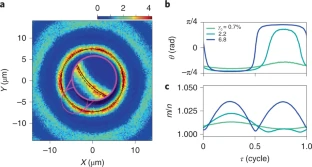Science Daily March 24, 2022
While it has been known that individual particle distribution influences yield point, or flow, in disordered materials, it has been challenging to study this phenomenon since the field lacks ways to “quantify” disorder in such materials. Researchers at the University of Pennsylvania tracked individual particles on top of a liquid-air interface. Then, they used a magnetic needle that moves back and forth to apply a shearing force. With this system, the researchers can systematically apply forces to 50,000 particles, track their detailed movement, and use complex image analysis to see if two neighboring particles remain next to one another after a shearing force is applied. They found that disordered materials can “remember” the forces that were applied to them, and that this memory can be measured by looking at individual particle distributions. The disordered materials lose this memory when a threshold of stress is surpassed, which occurs at the same time the material reaches its yield point and starts to flow. According to the researchers with such a wide range of systems that act like disordered materials, from eroding hillsides at risk of causing mudslides to living organisms such as biofilms, the possible implications for fields beyond thermodynamics are numerous…read more. TECHNICAL ARTICLE

Memory within microstructure. Credit: Nature Physics (2022)